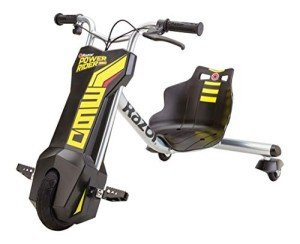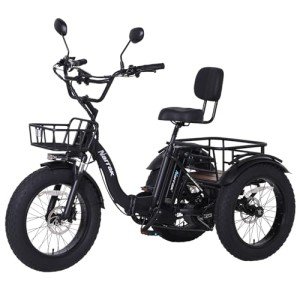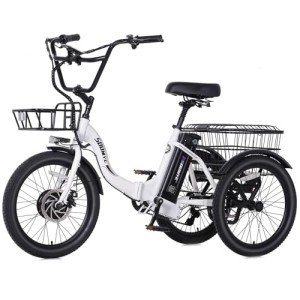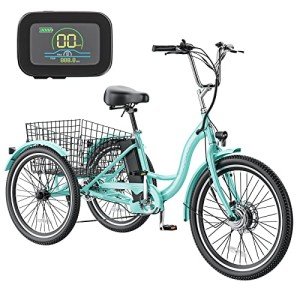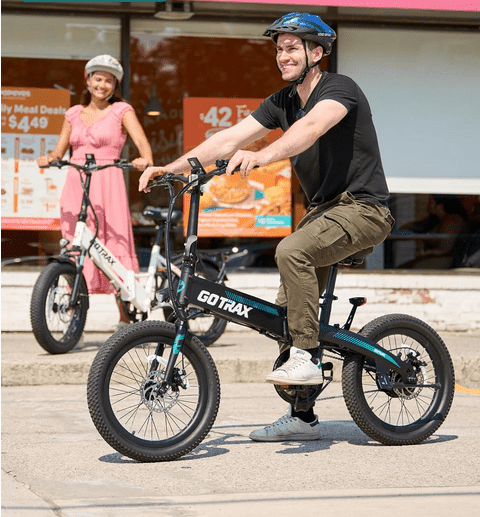Electric Bikes for Seniors in 2026: The Complete Guide
Staying active and independent gets trickier as we age. Electric bikes give seniors a practical way to keep moving without the aches that come with regular cycling.
Lots of older adults worry that traditional bikes are tough on their joints or that they just don't have the stamina for longer rides. E-bikes really change the game here.

Electric bikes for seniors focus on comfort, stability, and easy use—forget about speed. They usually have step-through frames, pedal assist, and safety features that make riding possible for folks over 55.
These bikes take away the usual headaches like steep hills, headwinds, and that tired, worn-out feeling that keeps people off bikes.
I've been digging into the newest 2026 models to help you find an e-bike that fits your life. Maybe you're running errands, riding for fun, or want to stay active—there's something out there for you.
Key Takeaways
- Electric bikes help seniors stay active with pedal assist that eases joint strain and fatigue.
- Step-through frames, fat tires, and strong brakes are the top safety features for older riders.
- Tricycles, folding bikes, and cargo bikes all serve different needs for senior riders.
Why Electric Bikes Are Ideal for Seniors
Electric bikes give seniors a blend of exercise, mobility, and independence that regular bikes just can't. That's huge for anyone who wants to stay active but is dealing with the usual age-related stuff.
Physical Health Benefits
Electric bikes deliver low-impact, gentle exercise that doesn't mess with your joints but still gets your heart pumping. The pedal-assist lets me pick how much energy I want to use each time I ride.
Some days, I want to cruise and take it easy. Other days, I feel like pushing myself a bit more. It's nice to have the choice and not worry about overdoing it.
Key health improvements include:
- Better heart health from regular cycling
- Stronger legs and improved balance
- More joint mobility, less pain
- Better mood and less stress from being outdoors
The motor means I never stress about getting too tired to make it home. That peace of mind makes me want to ride farther and more often, which is honestly great for my fitness.
E-bikes help keep my cycling skills sharp. Even if it's been years since I last rode, electric assist makes getting back on a bike feel easy and familiar.
Reducing Barriers to Mobility
Hills and wind don't stop me anymore. The motor kicks in when I need it most, and suddenly, those challenges just melt away.
Stuff like arthritis, less strength, or balance issues used to make cycling feel impossible. With an e-bike, I can manage those limitations and keep riding.
Common barriers electric bikes remove:
- Steep hills that wear you out
- Long distances that feel out of reach
- Windy days
- Worrying about getting stuck far from home
Step-through frames really help with getting on and off the bike. No more awkward leg swings or worrying about losing balance.
Many e-bikes for seniors come with wide seats, upright riding positions, and suspension. All these tweaks make long rides way more comfortable and easy on the joints.
Greater Independence and Daily Convenience
Electric bikes turn errands into something I actually look forward to. I can ride to the store, visit friends, or get to appointments without needing a lift.
They're way cheaper than owning a car. Charging costs almost nothing, and I don't have to think about gas or insurance.
Daily tasks that get easier:
- Shopping with cargo baskets
- Visiting friends and family
- Doctor's visits
- Trips to the park or just out for fun
E-bikes let me travel 40-60 miles on one charge. That opens up new places to explore that were just too far before.
The steady speed from the motor makes me feel more confident in traffic. I don't have to stress about slowing down on hills or falling behind other riders.
Key Features to Look for in Electric Bikes for Seniors

When I'm checking out electric bikes for seniors, I pay attention to what makes the ride safer and more comfortable. A good frame, comfy seat, solid battery, and manageable weight really matter.
Step-Through Frames for Accessibility
I always tell people to look for step-through frames first. With these, you step through instead of swinging your leg way up and over.
Why step-through frames are great:
- No high bar to trip over
- Easy to get off quickly if you need to
- Less stress on knees and hips
- Better balance when mounting and dismounting
If you've got mobility or balance issues, step-through frames make a big difference. Most have a step-over height of 12-16 inches, way lower than the usual 20-24 inches.
Aluminum frames hit the sweet spot for strength and weight. They don't rust, and they're tough enough without being too heavy.
Some step-through frames also keep the center of gravity low, which helps the bike feel steady—especially at slow speeds or when you're stopped.
Upright Riding Position and Comfort
I look for bikes that let you sit upright, not hunched over. It's easier on your back, neck, and wrists, especially on longer rides.
Comfort features to look for:
- Wide, cushy seats (7-9 inches across)
- Handlebars that come back toward you and adjust easily
- Grips that don't make your hands go numb
- Suspension seat posts to soak up bumps
Sitting upright also helps you see traffic better. You get a clearer view over cars and obstacles.
Tool-free seat adjustment is a small thing, but it's a lifesaver. You can tweak your seat height without hunting for tools or visiting a shop.
Wider tires—think 2.0-2.6 inches—also make the ride smoother and help with stability.
Battery Life and Removable Batteries
How far you can go depends on the battery. I suggest at least 400-500 watt-hours (Wh) for most folks.
What to know about batteries:
- Range: 20-40 miles per charge covers most needs
- Removable: You can charge it inside and keep it safe from theft
- Weight: Usually 5-7 pounds just for the battery
- Charging: Takes about 4-6 hours for a full charge
Removable batteries are super handy. I can charge mine in the kitchen or garage without dragging the whole bike in, and I don't worry about someone stealing it when I'm out.
Batteries do lose some juice over time. Good lithium batteries still hold 70-80% of their power after 500-800 charges. Storing and charging them right helps them last longer—trust me, it's worth it (more tips here).
Digital battery indicators are way easier to read than a row of blinking lights. I always look for a clear display so I know how much range I have left.
Weight and Ease of Handling
How heavy the bike is really affects how easy it is to move around, store, or lift. I tell most seniors to keep it under 60 pounds if possible.
Things that affect weight:
- Motor placement: Mid-drive motors balance the bike better than rear hub motors
- Frame material: Aluminum is 15-25% lighter than steel
- Battery weight: Adds 10-15 pounds
Lighter bikes are just easier to handle, especially at low speeds or when you're parking. Still, a little extra weight from the motor and battery can help keep things stable on straightaways.
Try handling the bike before you buy. Can you push it up a curb? Does it stay balanced when you're standing still?
If space is tight, folding e-bikes are worth a look. Good ones weigh 40-55 pounds and fit in car trunks or closets.
The balance of the bike matters more than the exact weight. Well-designed e-bikes spread the weight out, so you don't feel like the front or back is dragging you down.
Understanding Motor and Drive Systems

Electric bike motors usually come in two main types, each with different power levels and sensor setups. Your choice of motor changes how the bike feels, while the sensors decide how the motor reacts to your pedaling.
Hub Motors vs Mid-Drive Motors
Hub motors sit inside the front or rear wheel. They give the wheel direct power without using the bike's gears.
I think hub motors are simpler and quieter than other choices.
- Less maintenance needed
- Quieter operation
- Lower cost
- Simple installation
Hub motors work well on flat ground and gentle hills. The ride feels like the bike is being pushed forward.
Mid-drive motors mount near the pedals at the bike's center. They use the bike's gears to multiply power, which helps a lot on hills.
Mid-Drive Motor Benefits:
- Better hill climbing
- More natural riding feel
- Better weight balance
- Uses bike's gears
Mid-drive motors usually cost more and need more maintenance. The motor puts extra strain on chains and gears, so those wear out faster.
Choosing the Right Motor Power
Motor power affects how much help you get when pedaling. Most e-bikes for seniors use 350w to 500w motors for daily rides.
A 350w motor gives gentle assistance. It's good for flat areas and light hills, and you get longer battery life with a more natural feel.
If you need more muscle, a 1000w motor handles steep hills. Some bikes hit 1500w peak for short bursts, but more power drains the battery faster.
Power Recommendations:
- Flat areas: 350w motor
- Hilly areas: 500w-750w motor
- Very steep hills: 1000w motor
Check your local laws before buying. Many places limit e-bikes to 750W for street use.
Torque Sensors and Cadence Sensors
Sensors tell the motor when and how much to help you pedal. The two main types work very differently.
A cadence sensor detects when you start pedaling. It delivers steady power from the start, no matter how hard you push.
Cadence sensors cost less and are simpler. They provide consistent power but sometimes feel jerky at the start.
A torque sensor measures how hard you push the pedals. It gives more power when you pedal harder and less when you go easy.
This makes the ride feel more natural.
Torque Sensor Advantages:
- Smoother power delivery
- Better battery efficiency
- More natural feel
- Responds to your effort
Personally, I recommend torque sensors for most seniors. You get gentler starts and better control over the bike's power.
Safety and Braking Considerations for Seniors

Braking power and stability features directly impact senior rider safety and confidence. The right brake system reduces hand fatigue.
Suspension and tire choice also make a big difference in control on different surfaces.
Hydraulic vs Mechanical Disc Brakes
Hydraulic disc brakes need less finger strength than mechanical ones. That's a big plus for seniors with arthritis or a weaker grip.
The fluid system gives consistent stopping power. In my experience, hydraulic brakes respond smoothly and aren't as grabby as some mechanical setups.
Mechanical disc brakes use cables instead of fluid. They're cheaper and easier to maintain at home.
But mechanical brakes need more hand force for the same stopping power. Cables can stretch, so you'll need to adjust them from time to time.
For seniors, hydraulic systems offer better control. You can fine-tune the braking force to avoid sudden stops that could throw off your balance.
Hydraulic brakes also perform better in wet weather. Rain doesn't really affect their stopping power.
Suspension Systems and Shock Absorption
Front suspension forks absorb bumps and reduce vibration in your hands and arms. That can help prevent joint pain on longer rides.
Suspension systems come in different travel lengths. For seniors, 50-80mm of travel gives comfort without making the bike feel bouncy.
Rear suspension adds more comfort but also more weight and complexity. Most seniors find front suspension is enough.
Suspension seatposts are another option. They soak up road vibration without adding bulk to the front of the bike.
Shock absorption keeps tires in contact with the ground. That means better braking and less risk of losing control on rough spots.
Adjustable suspension lets you tweak the ride. Softer settings work better for lighter riders, while firmer ones suit heavier seniors.
Wheel Size and Fat Tires for Stability
20-inch tires give a lower center of gravity, so it's easier to get on and off the bike. But they don't roll over bumps as smoothly as bigger wheels.
26-inch and 27.5-inch wheels balance stability and the ability to roll over obstacles. Most seniors find these sizes work best.
Fat tires (3+ inches wide) offer great stability and comfort. They use lower air pressure, which helps soak up vibrations from the road.
The wider contact patch of fat tires improves grip on loose surfaces. That means less slipping on gravel or wet pavement.
Wheel size changes how the bike handles. Bigger wheels keep momentum better, but they take more effort to get moving from a stop.
Fat tires add weight and rolling resistance. Think about your usual riding terrain before choosing between standard and fat tires.
Electric Bike Types Best Suited for Seniors

Seniors do best with electric bikes that focus on easy mounting, stability, and comfort. Step-through frames mean you don't have to lift your leg high, and tricycles offer unbeatable balance for those with mobility concerns.
Step-Through and Step-Thru Electric Bikes
I always recommend step-through electric bikes for most seniors. These bikes have a low or missing top tube so you can step through the frame instead of swinging your leg over a high bar.
The step-through frame design makes getting on and off much safer. You don't have to worry about losing your balance.
Most step-through models put you in a comfortable, upright position. That means less strain on your back, neck, and wrists.
Key benefits include:
- Easy access for riders with limited mobility
- Reduced risk of falls during mounting
- Comfortable for riders wearing skirts or dresses
- Less physical strain when starting rides
Popular step-through models like the Velotric Discover 2 and Aventon Pace 4 add senior-friendly features. You'll often see adjustable stems, ergonomic grips, and suspension for extra comfort.
Folding Electric Bikes and Trikes
Folding electric bikes solve storage and transport headaches for many seniors. They fold down small, so they're perfect for apartments or RVs.
The folding electric bike category covers both two-wheel and three-wheel options. Two-wheel folders like the Ride1Up Portola stay portable without losing important features.
Folding electric trike models add the stability of three wheels and still fold for storage. These are great for seniors who need extra balance but don't have much space.
Most folding e-bikes weigh 50-65 pounds when folded. Not exactly light, but manageable for most folks with the right technique.
Storage size is usually around 33" x 19" x 30" folded. That fits in most car trunks, RVs, or even small closets.
Electric Tricycles for Maximum Stability
Electric tricycles offer the highest level of stability for seniors with balance or mobility issues. Three wheels mean you won't tip over at stops or slow speeds.
Electric trikes come in two main styles. Delta trikes have two wheels in the back, one in the front. Tadpole trikes flip that around.
Delta-style electric tricycles are more common for seniors. They feel familiar, kind of like the trikes you rode as a kid, but with adult comfort.
The wider wheelbase means trikes need more room to turn. Still, that's a fair trade for the extra confidence they give if you struggle with balance.
Many electric trikes come with big rear cargo baskets. You can haul groceries, bags, or even small medical equipment without worrying about tipping over.
Trikes are a solid pick for seniors who want to ride but can't safely balance on two wheels. They keep you independent and let you stay active outdoors.
Lightweight and Cruiser E-Bikes
Lightweight electric bikes under 50 pounds are easier to handle and move around. Less weight means less struggle when parking or storing the bike.
Cruisers have relaxed geometry, wide comfy seats, and upright riding positions. Swept-back bars and big saddles keep things comfortable rather than fast.
Cruiser-style e-bikes often include features like:
- Wide, ergonomic handlebars
- Plush, oversized seats
- Chain guards to protect clothing
- Built-in lights and reflectors
The Velotric Breeze 1 only weighs 50 pounds but still packs a 750W motor for hills. That mix of light weight and enough power works for a lot of seniors.
Lightweight electric bikes are easier to lift onto racks or carry up stairs. That matters if you need to transport or store your bike at a high elevation.
Cruiser geometry takes pressure off joints and muscles on long rides. The comfy position lets you enjoy the ride without aches and pains.
Cargo, Accessories, and Customization Options
Electric bikes for seniors really shine with the right add-ons. Storage, like rear racks and baskets, makes errands easier, and upgrades to the handlebars or drivetrain can boost comfort and performance.
Storage Baskets and Rear Racks
A rear rack is one of the best accessories for senior e-bike riders. Most racks safely carry 40-60 pounds and bolt right onto the frame.
Front and rear baskets give easy access to your stuff. Wire baskets work for groceries and small packages, while canvas baskets with covers keep things dry.
Look for quick-release baskets if you want to pop them off quickly. Some even have removable bags you can carry into the store.
Weight limits matter. Always check your bike's total payload before loading up. Most senior-friendly e-bikes can handle 275-420 pounds including the rider and cargo.
If storage is tight at home, folding baskets are handy. They collapse flat when you're not using them.
Panniers for Everyday Use
Panniers hang on both sides of your bike's rear rack. They help balance weight and keep your ride steady.
I like panniers with magnetic or clip-on attachments. These make it easy to attach or remove your bags—no more wrestling with straps.
If you ride in the rain, pick waterproof materials. Many panniers come with reflective strips, which help you stay visible at night.
Size options vary widely:
- Small panniers: 10-20 liters each
- Large panniers: 25-40 liters each
- Expandable models: grow 30-50% when needed
Some panniers switch into backpacks or shoulder bags once you hop off the bike. This comes in handy for groceries or errands.
External pockets are a must for quick access to your phone, keys, or wallet on the go.
Handlebars, Cranks, and Chainrings
Handlebar upgrades can make daily e-bike rides a lot more comfortable. Swept-back handlebars put you in an upright position, which takes pressure off your neck and back.
Adjustable stems let you play with height and angle until it feels just right. Try out a few setups—your body will tell you what works.
Ergonomic grips with palm rests help keep your hands from getting tired on long rides. Gel or foam grips soak up vibrations better than hard rubber.
Crank and chainring changes affect how hard you have to pedal. Shorter cranks (160-170mm) work well if you have knee or joint issues, since they need less bend.
Smaller chainrings make pedaling easier, though you might lose a bit of top speed without the motor. For most seniors, comfort beats speed anyway.
Some e-bikes let you swap chainrings without special tools. That flexibility is great if your needs change down the road.
Comparing Top-Rated Electric Bikes for Seniors in 2026
The 2026 e-bike market breaks down into three main types for older riders. Step-throughs balance comfort and performance, folding bikes solve storage headaches, and electric trikes offer unbeatable stability.
Best Overall Electric Bikes for Seniors
The URLIFE 1000W Fat Tire E-Bike is my top pick for seniors who want a solid, all-around bike. Its step-through frame makes it easy to get on—even if your knees or hips aren't what they used to be.
You get up to 80 miles of range thanks to the 48V 13Ah battery. The 20-inch fat tires grip all sorts of surfaces and feel stable.
Key specifications:
- 1000W peak motor power
- 28 mph top speed
- Step-through frame design
- Removable battery for easy charging
The Aventon Pace 500.3 Step-Through is another strong option. It's lighter than most, but still delivers plenty of power.
I like these models for seniors who want a bike for errands, light exercise, or just getting outside. The step-through frame is especially nice for anyone over 65.
Best Folding and Compact E-Bikes
The Spacewalk M6/M7 Series stands out if you don't have much storage. The M6 fits riders under 5'3", while the M7 is better for taller folks.
Both have a 1500W peak motor and a 48V 15Ah battery. The four-suspension system takes the edge off bumpy roads.
Size options:
- M6: 16-inch wheels for shorter riders
- M7: 20-inch wheels for average height riders
- Both models fold for easy storage
The RadRunner Plus is another good folding pick. It even has a passenger seat and some cargo space.
Folding e-bikes are a lifesaver if you live in an apartment or have a small garage. Most weigh 50-60 pounds once folded.
Best Electric Trikes and Tricycles
The Skeri Folding Electric Tricycle leads the pack with its three-wheel stability. You don't have to worry about balancing—just hop on and go.
It comes with front and rear baskets for your stuff. The 750W motor handles most situations without breaking a sweat.
Tricycle advantages:
- No balance required while riding
- Built-in storage compartments
- Step-through access
- 20 mph is a comfortable cruising speed
Electric trikes usually cost more than two-wheelers. They also take up more space, even when folded.
If you struggle with balance or want to carry a bunch of groceries, go with a trike. The three-wheel setup really builds confidence, especially if you haven't biked in a while.
Maintenance, Cost, and Long-Term Considerations
Knowing the ongoing costs and maintenance needs helps you decide if an e-bike is right for you. E-bikes made for seniors usually cost way less to maintain than a car, and with a bit of care, they last for years.
Ease of Maintenance for Senior Riders
I suggest bikes with belt drives instead of chains. Belt drives never need oil and don't rust, which is a huge plus.
They run quietly for thousands of miles. You won't have to mess with greasy chain oil or constant tune-ups.
Key maintenance advantages:
- No regular lubrication needed
- Silent operation
- Corrosion resistant
- Lasts 3-5 times longer than chains
E-bikes have fewer moving parts than cars. Most of the time, you just check tire pressure and wipe the bike down.
Many senior-friendly models have built-in lights powered by the main battery. That means no little batteries to replace.
Step-through frames also need fewer adjustments. Fewer parts mean less that can go wrong over time.
Battery Replacement and Upkeep
Most e-bike batteries last 2-4 years when used regularly. A 468Wh battery gives most seniors plenty of range without costing a fortune to replace.
Battery care basics:
- Store at room temperature
- Charge regularly, even during winter storage
- Avoid complete discharge
- Remove battery for indoor charging when possible
Replacement batteries usually run $300-$800, depending on size and brand. Top brands often offer longer warranties and better support.
Look for bikes with removable batteries. Charging indoors is easier, and it helps the battery last longer.
Most e-bikes let you pedal home if the battery dies. That's nice peace of mind, especially on longer rides.
Investing in Durability and Value
Good e-bikes for seniors run $1,500-$2,500 for the best mix of features and reliability. You can go cheaper—some start at $999—but you might deal with more repairs.
Premium brands offer up to 4-year warranties on big parts. That protection really helps if something major breaks.
Cost comparison over 5 years:
- Quality e-bike: $2,000 initial + $400 maintenance = $2,400 total
- Budget e-bike: $999 initial + $800 maintenance = $1,799 total
- Premium e-bike: $3,000 initial + $200 maintenance = $3,200 total
E-bikes cut fuel costs and help you drive less. Many seniors save $200-$500 a year on getting around.
It's worth considering a local dealer. Having nearby service makes life easier if your bike needs a fix.
Frequently Asked Questions
I get a lot of questions about electric bikes for seniors—everything from the best models and safety features to financial help and Medicare. Folks ask about coverage, practical folding options, and more.
What are the best electric bikes for seniors available in 2026?
Go for bikes with step-through frames and comfortable seats. Low-step models make it easy to get on and off, which is huge for safety.
Electric tricycles offer extra stability. Three wheels mean better balance, and most come with cargo baskets.
Look for adjustable pedal-assist levels. You get to pick how much the motor helps, so it fits your fitness.
Wide tires and a low center of gravity make for a steadier ride. Those features help prevent falls and just feel more comfortable.
How has Medicare's coverage for electric bikes changed for seniors in 2026?
Medicare still doesn't cover electric bikes as durable medical equipment. That hasn't changed in 2026.
Some Medicare Advantage plans might offer wellness perks, like bike discounts. It's worth checking your plan to see what's included.
If your doctor prescribes a bike for medical reasons, you might qualify for coverage—but the requirements are strict.
If you have a Health Savings Account, you might be able to use those funds for a bike. Sometimes, pre-tax dollars can be used for medical gear.
What are the most cost-effective electric bikes for seniors on the market in 2026?
Basic step-through e-bikes start around $1,200 to $1,800. They come with the safety essentials—no fancy extras driving up the price.
Pick a bike with at least a 250-watt motor. That's enough power for most rides without costing a fortune.
Check the battery range, too. A bike that goes 30-40 miles per charge is a good deal for most seniors.
Folding e-bikes cost more upfront, but you might save on storage if you're tight on space. They're perfect for apartments or condos.
Can seniors benefit from folding electric bikes, and what are the top models in 2026?
Folding bikes are a lifesaver if you have limited storage. They'll fit in your car trunk or a closet, no problem.
The main perk is portability for travel or getting around town. You can bring them on RVs, boats, or even public transit.
Most folding e-bikes weigh 45-60 pounds. Make sure that's something you can handle if you need to lift it.
Even for folding bikes, look for step-through frames. Getting on and off safely is always a priority.
What features should seniors look for in an electric bike for safety and comfort in 2026?
Step-through frames are the big one. You won't have to swing your leg over a high bar, which is safer and easier.
Integrated front and rear lights make you more visible. Built-in lights beat clip-ons every time.
Make sure you can adjust the seat height and handlebars. A good fit means less back pain and better control.
Wide, cushy seats help with back and hip comfort. Ergonomic handlebars also take pressure off your wrists and shoulders.
Throttle control is handy, too. You can cruise without pedaling when you need a break.
Are there any programs offering free or discounted electric bikes to seniors in 2026?
Some local senior centers team up with bike shops to give discounts. If you’re curious, call your area agency on aging and see what’s out there.
Certain utility companies hand out rebates for buying electric bikes. They're hoping more folks will choose eco-friendly ways to get around.
Veterans might have a shot at adaptive sports programs that include bikes. Your local VA office is the place to ask about those benefits.
Some non-profits fix up old bikes and give them to seniors who need them. These programs pop up in different places and depend a lot on funding.
Credit unions occasionally roll out special financing for electric bikes. A low-interest loan could make the price tag a bit less scary.
DISCLAIMER
This document is provided for general information purposes only and should not be relied upon as providing legal advice, technical, or specific operational guidance to the reader, whether as to the practices described in the document or the applicable legal requirements and regulations. Just Electric Bikes expressly disclaims any responsibility for liability arising from or related to the use or misuse of any information in this document.
DISCLAIMER
This document is provided for general information purposes only and should not be relied upon as providing legal advice, technical, or specific operational guidance to the reader, whether as to the practices described in the document or the applicable legal requirements and regulations. Just Electric Bikes expressly disclaims any responsibility for liability arising from or related to the use or misuse of any information in this document.

